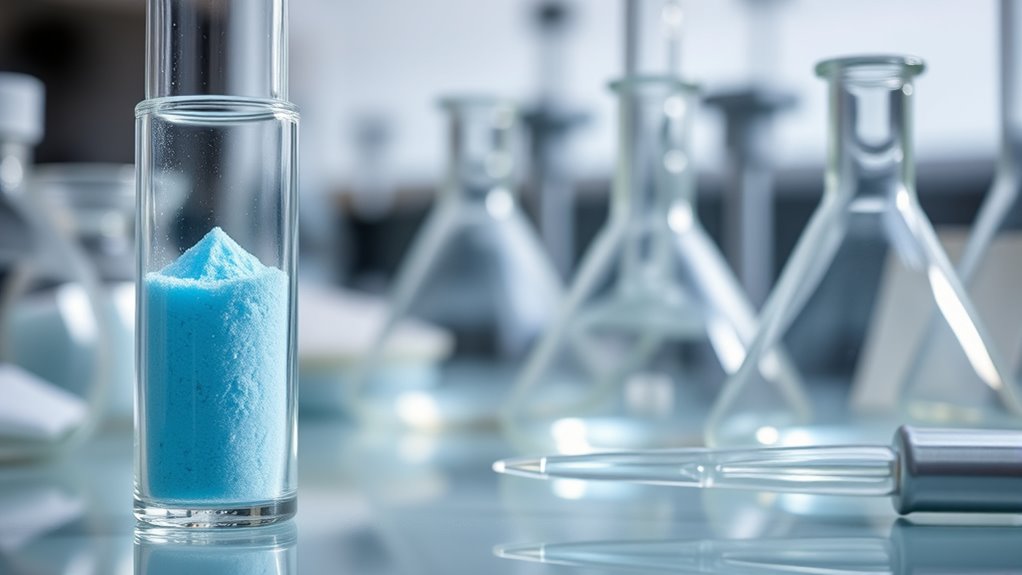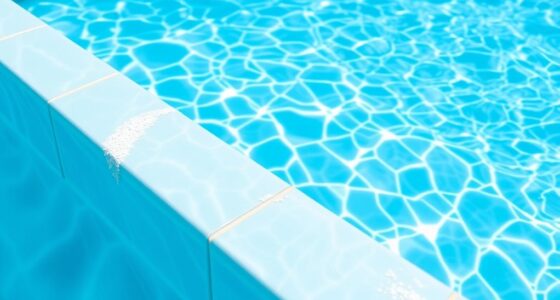Cyanuric acid is a chemical used in outdoor pools to protect chlorine from sunlight, helping your water stay sanitized longer. It absorbs UV rays, preventing chlorine from breaking down quickly. Keep levels between 30-50 ppm for safe, effective water. Too much can weaken disinfection; too little leaves your chlorine vulnerable. Managing cyanuric acid properly guarantees pool safety and efficiency. If you’re curious about how to maintain the right balance, there’s more to explore below.
Key Takeaways
- Cyanuric acid stabilizes chlorine in outdoor pools by protecting it from UV rays, extending its disinfecting power.
- Ideal cyanuric acid levels are between 30-50 ppm to balance chlorine protection and prevent disinfectant impairment.
- It absorbs UV rays, reducing chlorine breakdown, which saves costs and maintains water sanitation longer.
- Excessive cyanuric acid (above 50 ppm) can hinder chlorine’s ability to disinfect, risking water safety and clarity.
- Regular testing and proper management of cyanuric acid ensure effective UV protection and optimal pool water quality.
What Is Cyanuric Acid and Why Is It Used in Pools
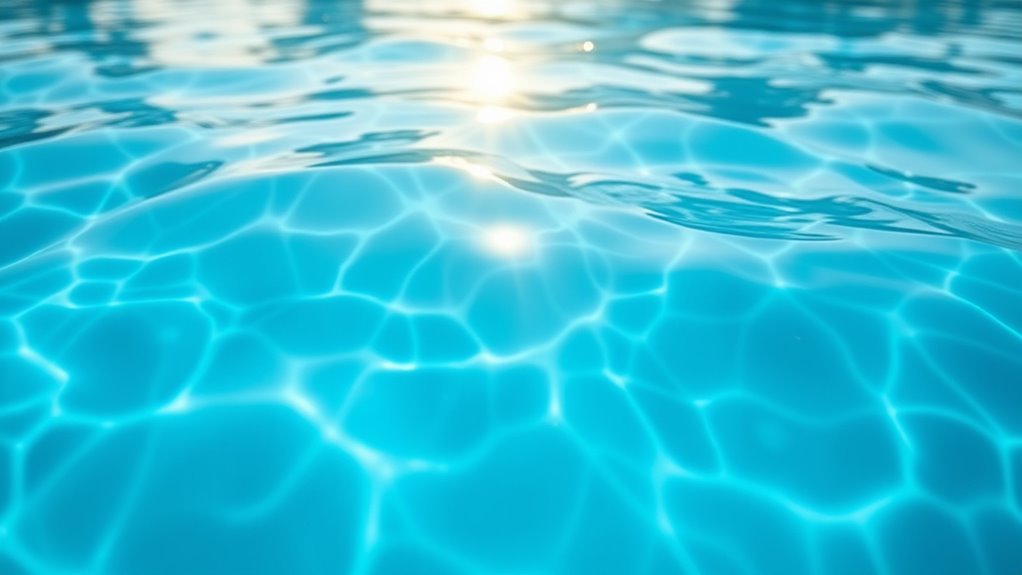
Have you ever wondered why pool water stays clear and balanced even after exposure to sunlight? The answer lies in cyanuric acid. This chemical is added to pools to stabilize chlorine, preventing it from breaking down quickly when hit by UV rays. Without cyanuric acid, sunlight can rapidly diminish chlorine levels, making it harder to keep the water clean and safe. Cyanuric acid acts as a protective shield, allowing chlorine to last longer and work more effectively. Its role in water chemistry management is crucial for maintaining water quality, especially in outdoor pools with high sun exposure. Proper cyanuric acid levels are essential for effective pool maintenance, ensuring the chlorine remains active and the water stays safe. Additionally, understanding regulatory frameworks related to chemical levels can help ensure compliance and safety. By adding cyanuric acid, you guarantee your pool stays clearer, safer, and easier to maintain. An understanding of water chemistry principles can also help pool professionals better communicate and serve their customers’ needs. It’s a simple but indispensable step in effective pool chemistry management.
How Cyanuric Acid Protects Chlorine From Sunlight
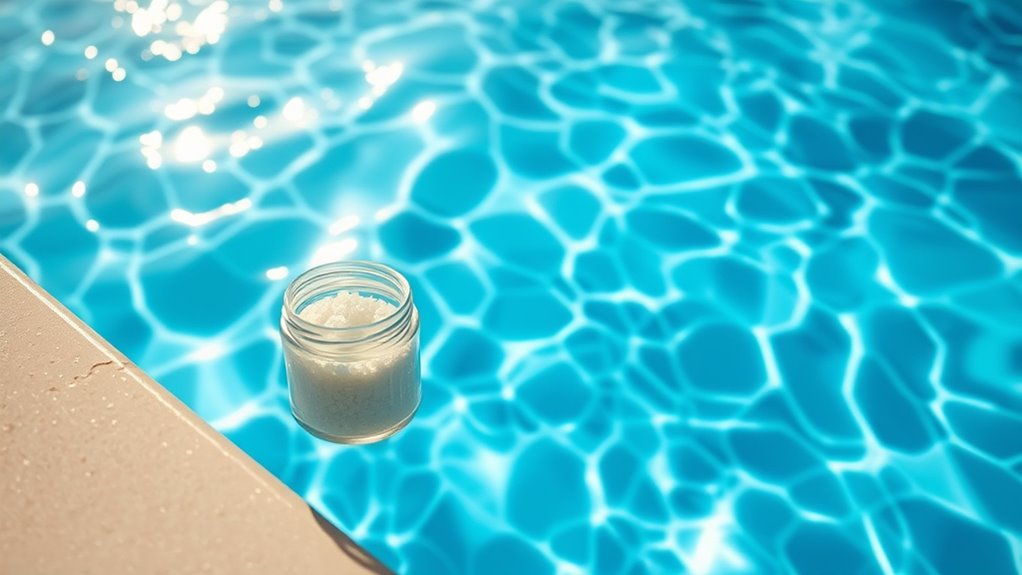
Cyanuric acid helps protect your chlorine from the damaging effects of sunlight by shielding it from UV rays. This slows down how quickly chlorine breaks down, so your pool stays sanitized longer. As a result, your pool chemicals last more effectively, saving you time and money. Additionally, understanding the risks associated with new payment technologies can help you make informed decisions about managing your merchant services. Proper use of cyanuric acid can also optimize pool maintenance routines and reduce chemical costs. Maintaining proper storage conditions for cyanuric acid is important to ensure its effectiveness over time. Ensuring correct application methods can further enhance its protective benefits, especially for large or distributed pools. Incorporating remote collaboration tools can further enhance your ability to monitor and adjust chemical levels efficiently, especially for large or distributed pools.
Shields Chlorine From UV
Sunlight’s ultraviolet (UV) rays can quickly break down chlorine in your pool, reducing its effectiveness at disinfecting. Cyanuric acid acts as a shield, absorbing UV rays before they can degrade chlorine molecules. This protection helps maintain a stable chlorine level, ensuring your pool stays sanitized longer. Without cyanuric acid, sunlight accelerates chlorine loss, forcing you to add chemicals more frequently. Additionally, proper pool water maintenance involves monitoring cyanuric acid levels to optimize chlorine stability. Proper chemical balance is essential for overall pool health and safety. Maintaining appropriate cyanuric acid levels also contributes to the overall efficiency of your pool’s sanitation system. Here’s a quick overview:
| UV Rays | Cyanuric Acid | Chlorine Stability |
|---|---|---|
| Break down | Absorbs UV rays | Extended effectiveness |
| Accelerate | Shields chlorine | Reduced chemical use |
| Cause loss | Maintains levels | Safer, cleaner pool |
Slows Chlorine Degradation Rate
By absorbing UV rays before they reach chlorine molecules, cyanuric acid considerably slows the rate at which chlorine degrades in your pool. When sunlight hits your pool water, UV radiation breaks down chlorine, reducing its effectiveness over time. Cyanuric acid acts as a protective barrier, intercepting these UV rays and preventing them from directly damaging chlorine molecules. This process allows chlorine to stay active longer, maintaining proper sanitation levels without constantly adding more. Additionally, understanding the proper levels of cyanuric acid in your pool ensures optimal protection without overuse. Proper credit card management and understanding transaction fees can also help pool owners budget for maintenance costs effectively. By slowing chlorine degradation, cyanuric acid helps you save on chemical costs and reduces the need for frequent chlorination. It’s a natural, effective way to extend the lifespan of your pool’s disinfectant, ensuring your water remains clean and safe for longer periods, even under intense sunlight. An optimal balance of cyanuric acid can also prevent issues such as overstabilization, which may hinder chlorine’s disinfecting ability. Expert advice emphasizes that understanding the role of cyanuric acid can optimize pool maintenance and safety.
Extends Pool Chemical Longevity
Because cyanuric acid absorbs UV rays before they reach chlorine molecules, it considerably extends the lifespan of your pool chemicals. This protection means you won’t need to add chlorine as often, saving you time and money. By stabilizing chlorine, cyanuric acid ensures your pool stays sanitized longer under sunlight. It acts as a shield, reducing the rapid breakdown caused by UV exposure. Additionally, maintaining proper cyanuric acid levels is essential for chemical stability, preventing chlorine degradation. To understand its benefits better, consider this table:
| Benefit | Explanation |
|---|---|
| Longer chlorine effectiveness | Chlorine remains active longer in sunlight |
| Fewer chemical additions | Reduces frequency of chemical dosing |
| Cost savings | Less frequent purchases of chlorine |
| Easier pool maintenance | Maintains water quality with less effort |
| Improved pool sanitation | Consistent disinfection in sunny weather |
Additionally, understanding industry trends helps you better manage pool chemical stability, and staying informed about disease prevention can help protect your pool environment.
Optimal Levels of Cyanuric Acid for Pool Safety
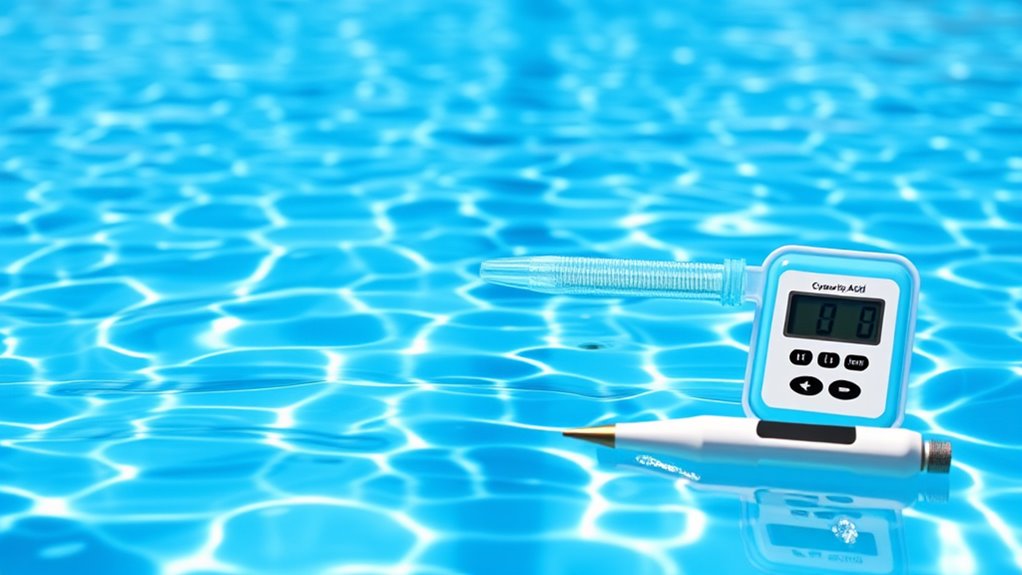
Maintaining the right cyanuric acid level is key to keeping your pool safe and effective. You should aim for the ideal range, but too much can cause problems, so it’s important to know how to adjust levels properly. Let’s look at the recommended range and what you need to do if levels get too high or low.
Ideal Cyanuric Acid Range
The ideal cyanuric acid range for pool safety typically falls between 30 and 50 parts per million (ppm). Maintaining this level helps protect your chlorine from UV degradation, ensuring your sanitizer remains effective longer. If your cyanuric acid is too low, your chlorine may dissipate quickly, requiring frequent adjustments. Conversely, if it’s too high, it can hinder chlorine’s ability to disinfect properly, even within the recommended range. Regular testing of your pool water is essential to keep cyanuric acid within this suitable window. Using a reliable test kit allows you to monitor levels accurately. Keeping cyanuric acid in this range strikes a balance between protecting chlorine and maintaining safe, clean water for swimmers. Staying within these levels supports overall pool health and safety.
Effects of Excess Levels
Excess cyanuric acid levels can substantially impair your pool’s disinfecting ability, even if the water appears clear. When levels are too high, chlorine becomes less effective at killing bacteria and algae. This means your pool isn’t as safe as it looks and could develop problems over time. To understand the impact, consider how cyanuric acid interacts with chlorine:
| Cyanuric Acid Level | Effect on Chlorine | Pool Safety Impact |
|---|---|---|
| 0-30 ppm | Enhances stability | ideal disinfecting |
| 30-50 ppm | Slight reduction | Still effective |
| 50-100 ppm | Noticeable decrease | Reduced safety |
| Over 100 ppm | Critically impaired | Unsafe |
| Over 200 ppm | Chlorine ineffective | Dangerous |
Adjusting for Safety
To guarantee your pool remains safe and effectively disinfected, it’s vital to keep cyanuric acid levels within the ideal range of 30 to 50 ppm. If levels fall below this, your chlorine may degrade quickly under sunlight, reducing its sanitizing power. To raise cyanuric acid, add the appropriate amount of stabilizer, following manufacturer instructions. If levels are too high, dilution is your best option—partially draining and refilling the pool reduces excess cyanuric acid. Regular testing with reliable kits helps you monitor levels accurately. Adjusting your cyanuric acid carefully ensures your pool stays safe, clean, and protected from the sun’s UV rays. Maintaining the correct balance minimizes chemical imbalances and keeps your pool water clear and healthy.
Signs That Cyanuric Acid Levels Need Adjustment

If your pool water isn’t clear or feels off, it might be a sign that your cyanuric acid levels need adjusting. You could notice your water turning cloudy, which signals the chlorine isn’t working effectively. You might also experience persistent algae growth despite regular cleaning. Another warning is increased chlorine consumption, making your pool chemicals more expensive. Ultimately, if your sanitizer levels drop quickly, it indicates your cyanuric acid might be too low, reducing chlorine’s stability. These signs can make your swimming experience less enjoyable and compromise safety. Keep an eye out for these symptoms; they’re your pool’s way of telling you something needs attention. Addressing cyanuric acid levels promptly helps maintain clear, healthy water you can trust.
Methods to Test and Measure Cyanuric Acid Concentration

Regularly testing your cyanuric acid levels guarantees your pool stays balanced and safe. To do this accurately, use a pool test kit designed for cyanuric acid, which typically includes test strips or liquid reagents. Test strips are quick and easy—simply dip them into the water and compare the color change to the chart. Liquid test kits involve adding reagents to a water sample and reading the resulting color. For precise measurements, consider electronic testers if available. Always follow the manufacturer’s instructions for proper use and timing. Testing regularly helps you catch any imbalances early and prevents potential issues caused by improper cyanuric acid levels. Consistent measurements keep your pool water safe, clear, and properly protected from UV degradation.
Managing Cyanuric Acid Levels Safely and Effectively
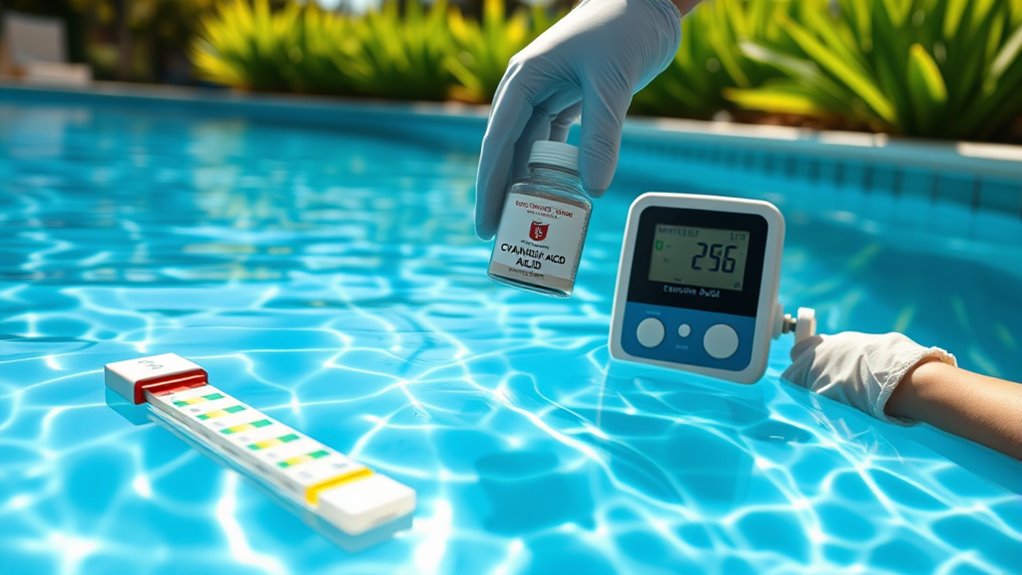
Managing cyanuric acid levels effectively requires staying within the recommended range to prevent pool issues. When your cyanuric acid is balanced, your pool stays clearer, safer, and easier to maintain. To do this:
- Regularly test your cyanuric acid levels to catch any fluctuations early.
- Adjust levels gradually by adding cyanuric acid or dilution water, avoiding sudden changes.
- Keep track of your water’s chemistry to identify trends over time.
- Consult a pool professional if you’re unsure about proper adjustments or if levels are consistently outside the safe range.
Potential Risks of Excessive Cyanuric Acid in Pool Water
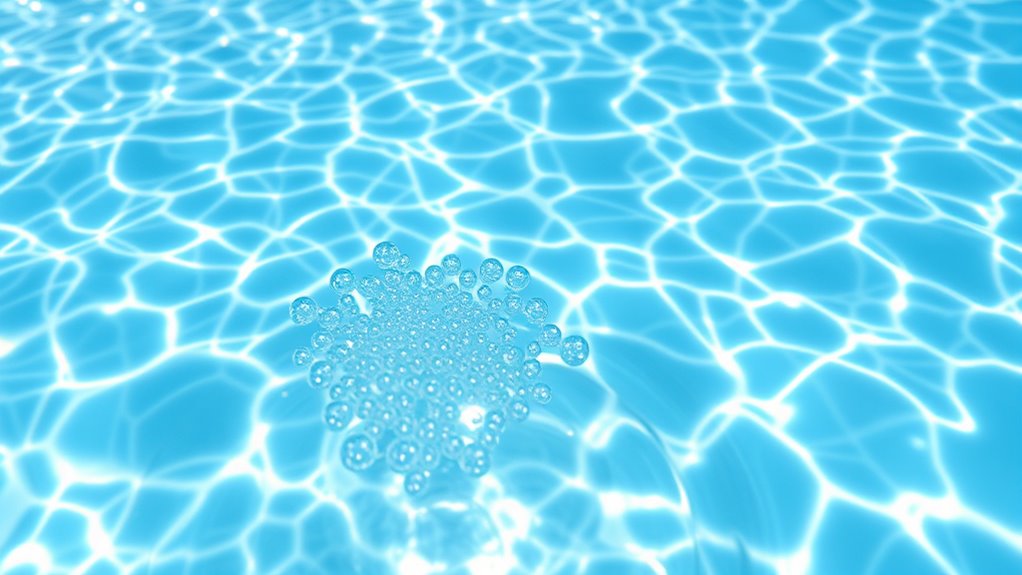
While maintaining proper cyanuric acid levels helps keep your pool safe and clear, allowing these levels to rise too high can cause serious problems. Excessive cyanuric acid reduces chlorine’s effectiveness, making it harder to disinfect your pool. This can lead to algae growth, cloudy water, and an increased risk of bacteria. You might also notice that your chlorine demand spikes, forcing you to add more chemicals to keep your water balanced. Over time, high cyanuric acid levels can cause your filtration system to work harder, increasing wear and tear. Additionally, maintaining such levels can complicate water testing, leading to inaccurate readings. To avoid these issues, regularly check your cyanuric acid levels and keep them within recommended ranges.
Frequently Asked Questions
Can Cyanuric Acid Be Used in Hot Tubs or Spas?
You might wonder if cyanuric acid is suitable for hot tubs or spas. Generally, it’s not recommended because hot water can break down cyanuric acid faster, reducing its effectiveness in stabilizing chlorine. Additionally, high temperatures can cause it to build up to unsafe levels, leading to skin or eye irritation. It’s better to use proper spa sanitizers and follow manufacturer guidelines for water stability and safety.
How Does Cyanuric Acid Interact With Other Pool Chemicals?
Imagine your pool chemicals are a band, each playing a crucial role. Cyanuric acid acts like a steady drummer, stabilizing the chlorine beat. It interacts with chlorine to prevent rapid degradation from sunlight, but too much can mute the entire performance, making sanitizer less effective. You should add cyanuric acid carefully, balancing it with other chemicals to keep your pool water clean, clear, and safe without disrupting the harmony.
Is Cyanuric Acid Safe for Children and Pets?
You’re wondering if cyanuric acid is safe for children and pets. Generally, it’s safe in the recommended levels when used properly for pool maintenance. However, ingestion or direct contact in high doses can cause irritation or health issues. To keep everyone safe, store cyanuric acid out of reach, handle it carefully, and maintain proper chemical balance. Always follow manufacturer instructions and consult a professional if unsure.
How Often Should Cyanuric Acid Levels Be Tested?
You should test cyanuric acid levels at least once a week if you’re maintaining a pool. Regular testing helps guarantee the stabilizer stays within the ideal range of 30-50 ppm, preventing potential issues like reduced chlorine effectiveness or algae growth. After heavy rain, high swimmer loads, or if you notice water quality changes, test more frequently. Consistent checks keep your pool safe, clean, and balanced for everyone’s enjoyment.
What Are Natural Alternatives to Cyanuric Acid?
You’re wondering about natural alternatives to cyanuric acid. While cyanuric acid stabilizes chlorine, you can try using mineral sanitizers like copper or silver ion systems, which naturally inhibit bacteria and algae. Regularly shocking your pool with non-chlorine oxidizers, maintaining proper pH levels, and using natural enzymes can also help keep your water clean without relying on cyanuric acid. These options promote a healthier, chemical-free swimming environment.
Conclusion
Now that you understand what cyanuric acid does and how to manage its levels, you might wonder—are your pool’s levels just right? Too much could hide problems, while too little leaves your chlorine vulnerable. Staying vigilant and testing regularly keeps your pool safe and sparkling. But what happens if those levels get out of control? Keep monitoring, stay informed, and the secret to a perfect pool remains in your hands.
